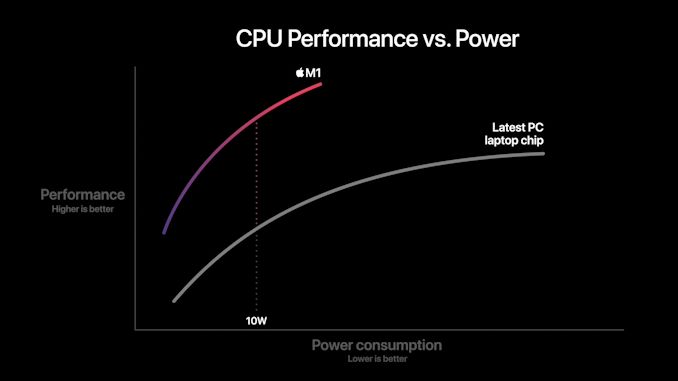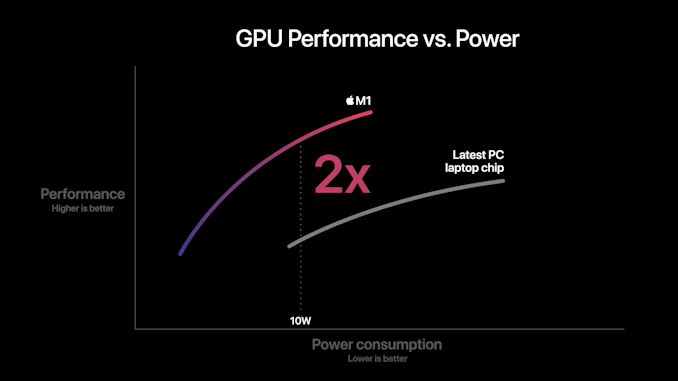Apple Announces The Apple Silicon M1: Ditching x86 - What to Expect, Based on A14
by Andrei Frumusanu on November 10, 2020 3:00 PM EST- Posted in
- Apple
- Apple A14
- Apple Silicon
- Apple M1
Apple Shooting for the Stars: x86 Incumbents Beware
The previous pages were written ahead of Apple officially announcing the new M1 chip. We already saw the A14 performing outstandingly and outperforming the best that Intel has to offer. The new M1 should perform notably above that.
We come back to a few of Apple’s slides during the presentations as to what to expect in terms of performance and efficiency. Particularly the performance/power curves are the most detail that Apple is sharing at this moment in time:
In this graphic, Apple showcases the new M1 chip featuring a CPU power consumption peak of around 18W. The competing PC laptop chip here is peaking at the 35-40W range so certainly these are not single-threaded performance figures, but rather whole-chip multi-threaded performance. We don’t know if this is comparing M1 to an AMD Renoir chip or an Intel ICL or TGL chip, but in both cases the same general verdict applies:
Apple’s usage of a significantly more advanced microarchitecture that offers significant IPC, enabling high performance at low core clocks, allows for significant power efficiency gains versus the incumbent x86 players. The graphic shows that at peak-to-peak, M1 offers around a 40% performance uplift compared to the existing competitive offering, all whilst doing it at 40% of the power consumption.
Apple’s comparison of random performance points is to be criticised, however the 10W measurement point where Apple claims 2.5x the performance does make some sense, as this is the nominal TDP of the chips used in the Intel-based MacBook Air. Again, it’s thanks to the power efficiency characteristics that Apple has been able to achieve in the mobile space that the M1 is promised to showcase such large gains – it certainly matches our A14 data.
Don't forget about the GPU
Today we mostly covered the CPU side of things as that’s where the unprecedented industry shift is happening. However, we shouldn’t forget about the GPU, as the new M1 represents Apple’s first-time introduction of their custom designs into the Mac space.
Apple’s performance and power efficiency claims here are really lacking context as we have no idea what their comparison point is. I won’t try to theorise here as there’s just too many variables at play, and we don’t know enough details.
What we do know is that in the mobile space, Apple is absolutely leading the pack in terms of performance and power efficiency. The last time we tested the A12Z the design was more than able to compete and beat integrated graphics designs. But since then we’ve seen more significant jumps from both AMD and Intel.
Performance Leadership?
Apple claims the M1 to be the fastest CPU in the world. Given our data on the A14, beating all of Intel’s designs, and just falling short of AMD’s newest Zen3 chips – a higher clocked Firestorm above 3GHz, the 50% larger L2 cache, and an unleashed TDP, we can certainly believe Apple and the M1 to be able to achieve that claim.
This moment has been brewing for years now, and the new Apple Silicon is both shocking, but also very much expected. In the coming weeks we’ll be trying to get our hands on the new hardware and verify Apple’s claims.
Intel has stagnated itself out of the market, and has lost a major customer today. AMD has shown lots of progress lately, however it’ll be incredibly hard to catch up to Apple’s power efficiency. If Apple’s performance trajectory continues at this pace, the x86 performance crown might never be regained.












644 Comments
View All Comments
valuearb - Tuesday, November 10, 2020 - link
Sure they are comparing against Skylake, but if it's nearly 3x faster than Skylake, that still means it's significantly faster than Tiger Lake, and uses less than half the power.And this is Apple's ENTRY LEVEL Apple Silicon CPU. What awaits us this spring?
Dolda2000 - Tuesday, November 10, 2020 - link
Regardless whom Apple are comparing themselves against, the point here is that AnandTech has compared them against the actual latest Tigerlake and Zen 3 parts.tuxRoller - Tuesday, November 10, 2020 - link
What does it matter?Anandtech posted their own benchmarks which can be directly compared to other cpus...including zen3.
If you're simply interested in the tech it doesn't matter what the marketing claims.
If the marketing aspect is what interests you this might not be a good forum for that discussion.
trixn86 - Wednesday, November 11, 2020 - link
They compared it to what they think is currently the most commonly used product in their product line. An 2.8x faster sounds better than 1.5x faster or whatever it will be compared to a current Tiger Lake. So even from a marketing perspective it is wise to chose the Skylake over the Tiger Lake to compare it.KarlKastor - Wednesday, November 11, 2020 - link
@AndreiThe question is, what is your problem?
He is arguing factly. Maybe he is wrong. Than proof that with facts.
Yes, it is a 5 page article. An this pages are full of single thread tests. I agree that they have one of the fastest core design. But the performance on multi threaded longer real world benchmarks might look different.
Your article is superb, but even you are nor perfect.
techconc - Wednesday, November 11, 2020 - link
@KarlKastor - The point of the article was to compare architecture performance of a core design. The point of the article is NOT to compare every multi-core implementation of these designs. Or course there will be Intel and AMD chips with MANY cores that will be faster than the phone based A14 chip. That's not the point of this article or even this discussion.KarlKastor - Thursday, November 12, 2020 - link
@techconcYou can not talk about desktop class performance and stick to architecture performance itself.
Yes, the architecture looks great, that is not new. But is it better than other CPUs? The test here can't answer. I hope Andrei has already a new Macbook ordered. ;)
Another thing is comparing the package power of the 3950X and the M1. The 3950X has 16 Cores and tons of IO. Sure it consumes much more. And also sure the A14 is still impressive, it is not even the M1.
Spunjji - Thursday, November 12, 2020 - link
@KarlKastor - they don't *have* the new M1 chip to compare, so how would they? They offered the best comparison they can give right now - one that simply measures architectural efficiency. No doubt the multicore benchmarks will come later, and no doubt the goalposts will be moved to a new reason why they don't matter. The fact remains that right now, with the best information we have available, it's clear that Apple have built a VERY capable chip.KarlKastor - Monday, November 16, 2020 - link
No one denied, that it is a capable chip.The diskussion is more about how to interpret this results.
techconc - Thursday, November 12, 2020 - link
@KarlKastor - Let's take a look at the A14 and the M1 for example. Is there an architecture difference between the CPU or even GPU cores in these chips? No. The only difference is the M1 chip is bigger (perhaps with more bandwidth) but it's just using the same cores adding more of them. I'd expect Apple's next chip in this family to follow that formula exactly... Same architecture, more cores. So, yes, if you understand the performance of 1 core, it's to hard to extrapolate performance for the same architecture as it scales with more cores. Do you think a 4 core Intel chips is fundamentally different from an 8 core Intel chip of the same family? No, of course it isn't.